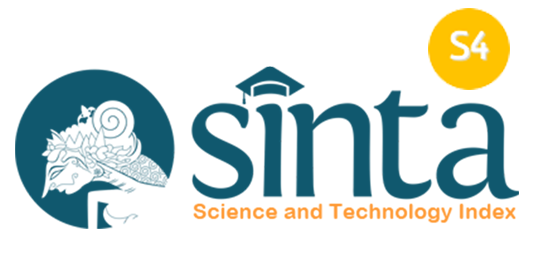Development of adversity quotient based geometry learning model for prospective teachers
Abstract
The objective of this research is to develop the adversity quotient-based and media-assisted model of mathematics teaching. The stages follow Plomp Model that involves (1) preliminary study, (2) designing (planning), (3) realization/ construction, (4) test, evaluation and revision, (5) implementation. Stages 1 through 3 were held in 2017, stages 4 and 5 completed in 2018 and 2019. Through the preliminary study, designing, and realization/construction, the researchers were able to construct the model in five components: syntax, social system, reaction principles, supporting system, and instructional and nurturing effect. The syntax of this model covers: introduction of learning objectives, motivating, the presentation of prerequisite material and the discussion structured task, student categorization based on adversity quotient, group discussion, group presentation, concluding the discussion, evaluation, and assigning structured-tasks individually and in groups.
Keywords
Full Text:
PDFReferences
Akpan, J. P., & Beard, L. A. (2016). Using constructivist teaching strategies to enhance academic outcomes of students with special needs. Universal Journal of Educational Research, 4(2), 392-398.
Bautista, M. J. C. (2015). Adversity quotient and teaching performance of faculty members. International Journal of Scientific and Research Publications, 5(3), 1-6.
Bennu, S. (2011). Proses berpikir siswa quitter pada sekolah menengah pertama dalam menyelesaikan masalah matematika. Edumatica, 1(2), 15–24.
Bennu, S. (2012). Adversity quotient: Kajian kemungkinan pengintegrasiannya dalam pembelajaran matematika. Aksioma, 1(1), 56–62.
Bennu, S. (2015). Proses berpikir siswa climber pada Kelas VII sekolah menengah pertama dalam menyelesaikan masalah matematika. Jurnal Pendidikan Matematika dan Terapan, 1(3), 52–64.
Boa, E. A., Wattanatorn, A., & Tagong, K. (2018). The development and validation of the Blended Socratic Method of Teaching (BSMT): An instructional model to enhance critical thinking skills of undergraduate business students. Kasetsart Journal of Social Sciences, 39(1), 81-89.
Blackmore, C. (2010). Social learning systems and communities of practice (pp. 44-50). London: Springer.
Cando, J. M. D., & Villacastin, L. N. (2014). The relationship between adversity quotient (AQ) and emotional quotient (EQ) and teaching performance of college PE faculty members of CIT University. International Journal of Sciences: Basic and Applied Research, 18(2), 354-357.
D’sousa, R. (2006). A study of adversity quotient of secondary school students in relation to their school performace and the school climate. Departement of Education University of Mumbay.
Gidena, A., & Gebeyehu, D. (2017). The effectiveness of advance organiser model on students’ academic achievement in learning work and energy. International Journal of Science Education, 39(16), 2226-2242.
Hema, G., & Gupta, M. (2015). Adversity quotient for prospective higher education. The International Journal of Indian Psychology, 4, 49-64.
Joyce, B., Weil, M., & Calhoun, E. (2009). Models of teaching (Eighth Edition). Boston: Allyn and Bacon.
Kamboj, S., Sarmah, B., Gupta, S., & Dwivedi, Y. (2018). Examining branding co-creation in brand communities on social media: Applying the paradigm of Stimulus-Organism-Response. International Journal of Information Management, 39, 169-185.
Kristanti, F., Ainy, C., Shoffa, S., Khabibah, S., & Amin, S. M. (2018). Developing creative-problem-solving-based student worksheets for transformation geometry course. International Journal on Teaching and Learning Mathematics, 1(1), 13–23.
Kroll, L. R., & Laboskey, V. K. (1996). Practicing what we preach: Constructivism in a teacher education program. Action in teacher education, 18(2), 63-72.
Marashi, H., & Rashidian, S. (2018). EFL teachers’ adversity quotient, personal growth initiative, and pedagogical success. Journal of Teaching Language Skills, 37(3), 93-139.
Noorloos, R., Taylor, S. D., Bakker, A., & Derry, J. (2017). Inferentialism as an alternative to socioconstructivism in mathematics education. Mathematics Education Research Journal, 29(4), 437-453.
Parvathy, U., & Praseeda, M. (2014). Relationship between adversity quotient and academic problems among student teachers. Journal of Humanities and Social Science, 19(11), 23-26.
Pea, R. D. (2004). The social and technological dimensions of scaffolding and related theoretical concepts for learning, education, and human activity. The journal of the learning sciences, 13(3), 423-451.
Plomp, T. (1997). Educational and training system design. Univercity of Twente.
Santos, M. C. J. (2012). Assessing the effectiveness of the adapted adversity quotient program in a special education school. Researchers World, 3(4), 13-23.
Stoltz, P. G. (1997). Adversity quotient: Turning obstacles into opportunities. John Wiley & Sons.
Stoltz, P. G. (2000). Adversity quotient: Turning obstacles into opportunities (Mengubah hambatan menjadi peluang). PT. Gramedia Widiasarana Indonesia.
Vrasidas, C. (2000). Constructivism versus objectivism: Implications for interaction, course design, and evaluation in distance education. International journal of educational telecommunications, 6(4), 339-362.
Wenger, E. (2010). Communities of practice and social learning systems: the career of a concept. In Social learning systems and communities of practice (pp. 179-198). Springer, London.
Wheatley, G. H. (1991). Constructivist perspectives on science and mathematics learning. Science Education, 75(1), 9-21.
Yani, M., Ikhsan, M., & Marwan, M. (2016). Proses berpikir siswa sekolah menengah pertama dalam memecahkan masalah matematika berdasarkan langkah-langkah Polya ditinjau dari adversity quotient. Jurnal Pendidikan Matematika, 10(1), 43-57.
DOI: https://doi.org/10.18860/ijtlm.v2i2.9352
Refbacks
- There are currently no refbacks.
Copyright (c) 2020 International Journal on Teaching and Learning Mathematics

This work is licensed under a Creative Commons Attribution-NonCommercial-ShareAlike 4.0 International License.
Indexed by :
.png)
.jpg)
.png)

.jpg)



